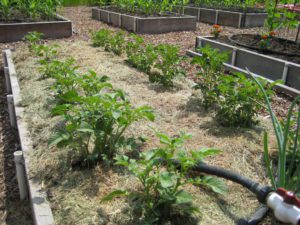May 22 column: Conserving water

Considering the unseasonably warm temperatures we’ve been experiencing this spring, I felt it would be important to write about conserving water in our gardens. Here’s is a link to my column in today’s edition of The Spokesman-Review: Save water by paying attention to soil, plant needs.
Much of it is about irrigation practices in times of drought, which is something I learned about while attending the Tilth Producers of Washington’s conference last fall. In my column, I have listed a few resources you can use to closely monitor the weather in your region as well as monitor the water you’re using in your garden or on your lawn. In this day and age, we might as well take advantage of technology, right?
As we go through this year’s garden season, here are the important things to remember:
- Plants require different amounts of water during the season, so adjust your watering practices accordingly to make the best use of this precious resource.
- The ideal time to water your vegetable garden and flower beds is early morning. There will be less evaporation at this time of day plus it’s easier on the plants. If you water in the middle of the day, the cold water from the sprinklers shocks the plants.
- When it comes to lawns, the best time to water is in the evening. Usually, I don’t recommend watering at night because it can cause disease problems for veggies, perennials and shrubs. However, lawns are the exception to the rule, plus you’ll find your lawn will stay more hydrated by watering in the evening.
- If possible, use a drip irrigation system or soaker hose set-up in your garden. This delivers the water near the roots, which is right where it does the most good. And besides, there is a lot of evaporation that takes place with overhead watering.
- If you don’t have an automatic sprinkler system, consider purchasing an inexpensive battery-operated timer that you attach to an outdoor faucet. They work really well and it saves you from having to drag your hoses around to all of the plants.
- Mulch, mulch, mulch! If you place mulch on the soil around your plants that will benefit them (and you) in two ways: first, the mulch will conserve moisture in the soil, and second, you’ll have less weeding to do. I generally use grass clippings for a mulch (see photo below) because we don’t use any chemicals on our lawn. But you could use shredded leaves or straw.
 If you have other ideas for ways to conserve moisture, drop me a note at Susan@susansinthegarden.com. I love hearing what other gardeners are doing!
If you have other ideas for ways to conserve moisture, drop me a note at Susan@susansinthegarden.com. I love hearing what other gardeners are doing!
